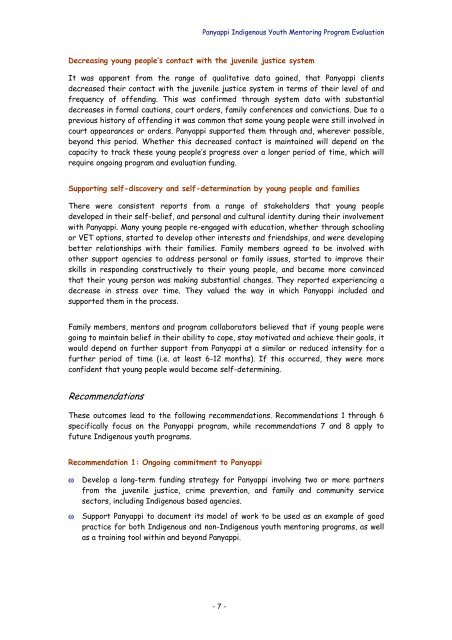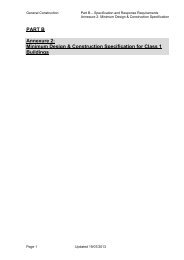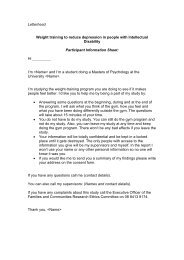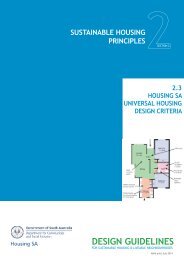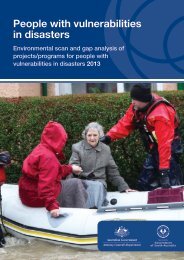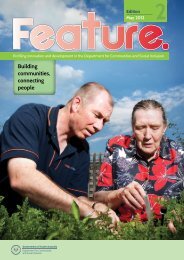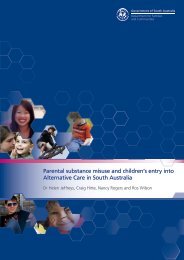Panyappi Indigenous Youth Mentoring Program Evaluation
Panyappi Indigenous Youth Mentoring Program Evaluation
Panyappi Indigenous Youth Mentoring Program Evaluation
Create successful ePaper yourself
Turn your PDF publications into a flip-book with our unique Google optimized e-Paper software.
<strong>Panyappi</strong> <strong>Indigenous</strong> <strong>Youth</strong> <strong>Mentoring</strong> <strong>Program</strong> <strong>Evaluation</strong><br />
Decreasing young people’s contact with the juvenile justice system<br />
It was apparent from the range of qualitative data gained, that <strong>Panyappi</strong> clients<br />
decreased their contact with the juvenile justice system in terms of their level of and<br />
frequency of offending. This was confirmed through system data with substantial<br />
decreases in formal cautions, court orders, family conferences and convictions. Due to a<br />
previous history of offending it was common that some young people were still involved in<br />
court appearances or orders. <strong>Panyappi</strong> supported them through and, wherever possible,<br />
beyond this period. Whether this decreased contact is maintained will depend on the<br />
capacity to track these young people’s progress over a longer period of time, which will<br />
require ongoing program and evaluation funding.<br />
Supporting self-discovery and self-determination by young people and families<br />
There were consistent reports from a range of stakeholders that young people<br />
developed in their self-belief, and personal and cultural identity during their involvement<br />
with <strong>Panyappi</strong>. Many young people re-engaged with education, whether through schooling<br />
or VET options, started to develop other interests and friendships, and were developing<br />
better relationships with their families. Family members agreed to be involved with<br />
other support agencies to address personal or family issues, started to improve their<br />
skills in responding constructively to their young people, and became more convinced<br />
that their young person was making substantial changes. They reported experiencing a<br />
decrease in stress over time. They valued the way in which <strong>Panyappi</strong> included and<br />
supported them in the process.<br />
Family members, mentors and program collaborators believed that if young people were<br />
going to maintain belief in their ability to cope, stay motivated and achieve their goals, it<br />
would depend on further support from <strong>Panyappi</strong> at a similar or reduced intensity for a<br />
further period of time (i.e. at least 6-12 months). If this occurred, they were more<br />
confident that young people would become self-determining.<br />
Recommendations<br />
These outcomes lead to the following recommendations. Recommendations 1 through 6<br />
specifically focus on the <strong>Panyappi</strong> program, while recommendations 7 and 8 apply to<br />
future <strong>Indigenous</strong> youth programs.<br />
Recommendation 1: Ongoing commitment to <strong>Panyappi</strong><br />
ω<br />
ω<br />
Develop a long-term funding strategy for <strong>Panyappi</strong> involving two or more partners<br />
from the juvenile justice, crime prevention, and family and community service<br />
sectors, including <strong>Indigenous</strong> based agencies.<br />
Support <strong>Panyappi</strong> to document its model of work to be used as an example of good<br />
practice for both <strong>Indigenous</strong> and non-<strong>Indigenous</strong> youth mentoring programs, as well<br />
as a training tool within and beyond <strong>Panyappi</strong>.<br />
- 7 -


